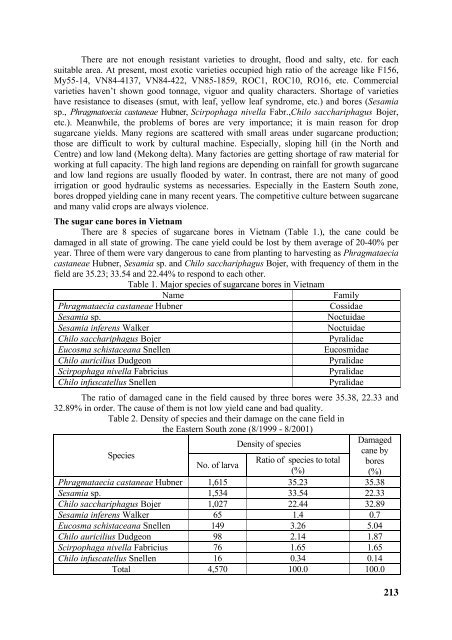TUYEÅN TAÄP
tuyeÃ¥n taäp - CHUYÃN TRANG GIá»I THIá»U CÃC GIá»NG MÃA Tá»T ...
tuyeÃ¥n taäp - CHUYÃN TRANG GIá»I THIá»U CÃC GIá»NG MÃA Tá»T ...
- No tags were found...
Create successful ePaper yourself
Turn your PDF publications into a flip-book with our unique Google optimized e-Paper software.
There are not enough resistant varieties to drought, flood and salty, etc. for each<br />
suitable area. At present, most exotic varieties occupied high ratio of the acreage like F156,<br />
My55-14, VN84-4137, VN84-422, VN85-1859, ROC1, ROC10, RO16, etc. Commercial<br />
varieties haven’t shown good tonnage, viguor and quality characters. Shortage of varieties<br />
have resistance to diseases (smut, with leaf, yellow leaf syndrome, etc.) and bores (Sesamia<br />
sp., Phragmatoecia castaneae Hubner, Scirpophaga nivella Fabr.,Chilo sacchariphagus Bojer,<br />
etc.). Meanwhile, the problems of bores are very importance; it is main reason for drop<br />
sugarcane yields. Many regions are scattered with small areas under sugarcane production;<br />
those are difficult to work by cultural machine. Especially, sloping hill (in the North and<br />
Centre) and low land (Mekong delta). Many factories are getting shortage of raw material for<br />
working at full capacity. The high land regions are depending on rainfall for growth sugarcane<br />
and low land regions are usually flooded by water. In contrast, there are not many of good<br />
irrigation or good hydraulic systems as necessaries. Especially in the Eastern South zone,<br />
bores dropped yielding cane in many recent years. The competitive culture between sugarcane<br />
and many valid crops are always violence.<br />
The sugar cane bores in Vietnam<br />
There are 8 species of sugarcane bores in Vietnam (Table 1.), the cane could be<br />
damaged in all state of growing. The cane yield could be lost by them average of 20-40% per<br />
year. Three of them were vary dangerous to cane from planting to harvesting as Phragmataecia<br />
castaneae Hubner, Sesamia sp. and Chilo sacchariphagus Bojer, with frequency of them in the<br />
field are 35.23; 33.54 and 22.44% to respond to each other.<br />
Table 1. Major species of sugarcane bores in Vietnam<br />
Name<br />
Family<br />
Phragmataecia castaneae Hubner<br />
Cossidae<br />
Sesamia sp.<br />
Noctuidae<br />
Sesamia inferens Walker<br />
Noctuidae<br />
Chilo sacchariphagus Bojer<br />
Pyralidae<br />
Eucosma schistaceana Snellen<br />
Eucosmidae<br />
Chilo auricilius Dudgeon<br />
Pyralidae<br />
Scirpophaga nivella Fabricius<br />
Pyralidae<br />
Chilo infuscatellus Snellen<br />
Pyralidae<br />
The ratio of damaged cane in the field caused by three bores were 35.38, 22.33 and<br />
32.89% in order. The cause of them is not low yield cane and bad quality.<br />
Table 2. Density of species and their damage on the cane field in<br />
the Eastern South zone (8/1999 - 8/2001)<br />
Species<br />
Density of species<br />
Damaged<br />
cane by<br />
bores<br />
(%)<br />
No. of larva<br />
Ratio of species to total<br />
(%)<br />
Phragmataecia castaneae Hubner 1,615 35.23 35.38<br />
Sesamia sp. 1,534 33.54 22.33<br />
Chilo sacchariphagus Bojer 1,027 22.44 32.89<br />
Sesamia inferens Walker 65 1.4 0.7<br />
Eucosma schistaceana Snellen 149 3.26 5.04<br />
Chilo auricilius Dudgeon 98 2.14 1.87<br />
Scirpophaga nivella Fabricius 76 1.65 1.65<br />
Chilo infuscatellus Snellen 16 0.34 0.14<br />
Total 4,570 100.0 100.0<br />
213






